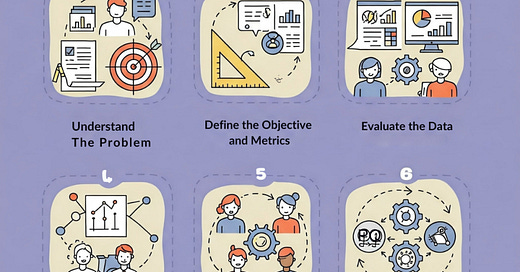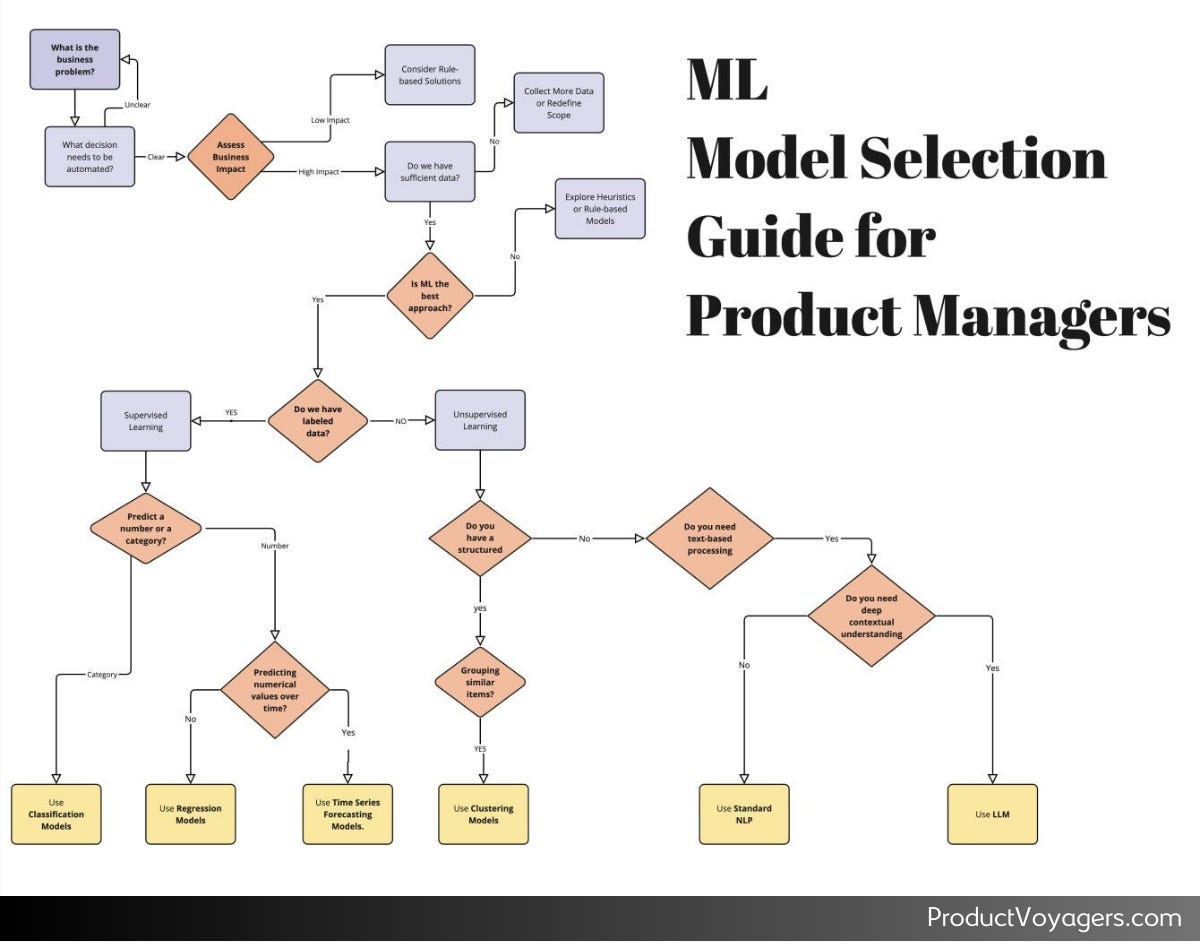The Million-Dollar ML Decision Framework Every Product Manager Needs
How To Select The Perfect Machine Learning Model Without a Data Science Degree!
This is a free edition of . To unlock full playbooks, tools, templates and expert takes — go Prime.
💡 This edition is backed by Velents.ai — The AI team behind smarter hiring and scalable automation — from influencer marketing to enterprise ops.
🚨 SHOCKING TRUTH: 85% of AI/ML projects fail before they even reach production.
The cost? Millions wasted. Opportunities lost. Teams burned out.
But what if you had a system that helped you consistently choose the right machine learning solution—without needing to be a data scientist?
As product managers, we’re under constant pressure to deliver “AI magic.”
Yet most of us never got formal training in ML—and we’re rarely given a translation guide.
We’re expected to speak both languages: business goals and technical complexity.
And too often, we’re stuck in the middle—guessing.
Let’s try to ease—or even end—that feeling today.
But remember: The difference between a million-dollar ML solution and an expensive failure often comes down to how well the product manager frames the problem.
🔍 The Problem with ML and AI Products: It’s not the tech. It’s the translation.
Before we dive into the solution, let’s name the elephant in the room:
ML projects don’t usually fail because of bad algorithms or lack of talent.
They fail because no one’s bridging the gap between data science and business.
Data scientists speak one language. Business stakeholders speak another.
And in between is you—expected to be fluent in both, without clear structure or support.
The real issue isn’t expertise.
It’s the lack of a clear decision-making framework that connects business needs to the right Machine-Learning “ML” approach.
And that’s exactly why is here today.
Meet Maie: Navigating where Product Strategy and AI collide 👇
With over a decade of experience navigating the complex landscape between technical teams and business stakeholders, and as a voyager in the complex waters of AI-driven product development, Maie has pioneered decision thinking that transform abstract machine learning concepts into tangible business outcomes.
🎤 Now over to Maie 👇
Hi, Voyagers 👋
This isn’t just another theoretical guide — I’ll walk you through real-world examples from Fashion, demand and supply chain, plus everyday practices we used to boost efficiency, double ROI, and cut decision time in half using ML and AI products.
💡 THE 6-STEP ML DECISION FRAMEWORK
This framework has been battle-tested across industries — from retail to fintech to manufacturing.
Follow the steps, and you’ll start to see the fog between business goals and ML solutions begin to clear. It might look straightforward — you’ve probably heard similar advice before — but the real value is in knowing where things go wrong.
I’ll point out the common traps and the lessons we learned the hard way.
STEP #1: Understand The Problem 🎯
The critical question isn't "Which ML model should we use?" but "What business problem are we actually solving?"
Start by understanding the business impact and stakeholder needs. Ask yourself:
Who will use the model? (Buyers, marketers, operations teams)
What decisions need automation or support?
What is the business impact? (Revenue increase, cost savings, operational efficiency)
Are there practical constraints? (Real-time processing, interpretability requirements)
Real-world example: When optimizing fashion inventory, consider:
Key stakeholders: Merchandising teams making assortment decisions
Decisions needing support: Stock allocation across regions, product prioritization
Business impact: Reduced markdowns, improved inventory efficiency
Constraints: Results need to be explainable to non-technical buyers
⚠️ COMMON PITFALLS TO AVOID:
Jumping to ML without a clear problem statement → Validate the business need before investing in ML.
Ignoring stakeholder alignment → Ensure end-users (e.g., buyers, supply chain teams) understand and trust the model.
Chasing the latest ML trend → Remember that sometimes simple rules-based systems outperform complex ML for well-defined problems.
POWER MOVE: Interview stakeholders who will use the model. Their needs should drive your requirements, not the other way around.
📌 TAKEAWAY: Define the business problem with such clarity that even someone outside your company could understand exactly what you're trying to achieve.
STEP #2: Define Objectives and Metrics 📊
Clear goals are your north star! Without them, it's hard to know if ML is worth the investment. Define what success looks like:
The model's objective (e.g., predict demand, detect fraud, recommend products)
Success metrics (e.g., accuracy, precision/recall, revenue impact)
Real-world example: Setting Metrics for Demand Forecasting:
Forecast accuracy measured by Mean Absolute Percentage Error (MAPE)
Revenue uplift from optimized assortments in A/B testing
Stock efficiency improvements, reducing excess inventory
⚠️ COMMON PITFALLS TO AVOID:
Focusing only on accuracy → Business impact (e.g., revenue, stock efficiency) matters more than model precision.
Not aligning on success metrics → Ensure leadership and teams agree on what "good performance" looks like.
Setting unrealistic expectations → Be honest about what ML can and cannot do; overpromising leads to disappointment.
POWER MOVE: Create a metrics dashboard that both executives and data scientists agree to upfront.
📌 TAKEAWAY: If you can't measure it, you can't improve it. Set concrete targets that align technical performance with business outcomes.
STEP #3: Evaluate The Data 💾
Garbage in, garbage out. You need to carefully evaluate:
Key data dimensions:
Sources: What internal and external data exists?
Volume: Do you have enough historical examples?
Quality: Is it accurate, complete, and consistent?
Distribution: Are there imbalances or biases?
Freshness: How often is it updated?
Real-world example: A data audit for fashion might reveal:
Sufficient past sales data exists for most product categories
No historical sales data for newly launched products
Missing external factors like weather or social media trends
Data skews toward bestsellers, potentially overlooking niche products
⚠️ COMMON PITFALLS TO AVOID:
Not validating data quality early → Ensure completeness, accuracy, and consistency before modeling.
Ignoring seasonality and trends → Factor in external events (e.g., holidays, weather) that impact demand.
Overlooking bias in data → If only past sales trends are used, the model may fail to capture diverse customer segments.
Using inconsistent data sources → When product IDs don't match across systems, even the best ML models will produce poor outputs.
POWER MOVE: Ask your data team to create a "data health assessment" for each critical dataset before investing in model development.
📌 TAKEAWAY: Be brutally honest about your data limitations. The strongest ML models can't overcome fundamentally flawed data.
STEP #4: Categorise The Problem Type 🧩
After you've checked out your data, the next step is picking the right ML approach:
Simple problem categorization:
Predicting a yes/no outcome? → Classification (e.g., churn prediction)
Forecasting a number? → Regression or Time Series (e.g., demand forecasting)
Finding patterns or groups? → Clustering (e.g., customer segmentation)
Detecting unusual events? → Anomaly Detection (e.g., fraud detection)
Personalizing content? → Recommendation Systems (e.g., product suggestions)
Working with text/images? → NLP or Computer Vision (e.g., sentiment analysis)
Real-world example from fashion inventory:
Use traditional time series forecasting for products with historical data
Apply alternative approaches (e.g., similarity-based methods) for new products
⚠️ COMMON PITFALLS TO AVOID:
Choosing the wrong ML approach → Use business questions to guide model selection.
Ignoring problem complexity → Start simple, then iterate if needed.
Ignoring interpretability needs → If stakeholders need explanations, avoid black-box models.
Over-engineering the solution → Remember: the best ML approach is the simplest one that solves your problem.
POWER MOVE: Create a decision tree flowchart that maps business problems to ML approaches for your specific industry.
📌 TAKEAWAY: You don't need to know how to build ML models, but you do need to know which type fits your problem.
STEP #5: Collaborate W/ Data Scientists 🤝
Creating an ML model requires everyone to work together. As a PM, your job is to turn business needs into ML requirements and make sure everyone's on the same page.
Critical alignment points:
Define success criteria together
Bridge the gap between business and ML
Work together on model selection and interpretability trade-offs
Communicate model results in business terms
Real-world example: For fashion inventory:
Create regular reviews with buyers and data scientists
Develop explanations for recommendations that make sense to business users
Establish a system to flag when model confidence is low
⚠️ COMMON PITFALLS TO AVOID:
Misaligned Expectations → Set success criteria upfront.
PMs Overpromising to Leadership → Align feasibility with data science teams first.
PMs Getting Too Technical → Focus on impact, not algorithms – let data scientists handle the model details.
Assuming data scientists understand the business context → Give data teams real-world use cases to fine-tune assumptions.
Stakeholder Resistance to ML → Prioritize interpretability and business impact over complexity.
POWER MOVE: Schedule sessions where business users and data scientists co-create the solution approach.
📌 TAKEAWAY: Build a translation layer between technical and business teams—this is YOUR most valuable role as a product manager.
STEP #6: Iterate and Keee…ep Testing 🔄
An ML model is never truly "finished"—it needs continuous monitoring, testing, and refinement to stay relevant. Business environments change, customer behaviors shift, and models degrade over time.
Essential post-deployment activities:
Train and validate the model with historical data
Deploy in a controlled environment before scaling
Monitor performance over time to detect drift
Iterate based on feedback and new business needs
Real-world example: For fashion inventory:
Set up model monitoring to detect performance changes
Retrain the model periodically with new data
Test across different regions to account for market variations
⚠️ COMMON PITFALLS TO AVOID:
Deploying Too Quickly → Always validate the model in a controlled environment first.
Ignoring Business Feedback → Ensure domain experts review model results.
Overfitting to Historical Data → Regularly validate on new data.
Ignoring model drift → Set up monitoring dashboards to track performance over time.
Delaying retraining → Automate retraining triggers when key metrics degrade.
POWER MOVE: Create a "model health" tracking system that combines technical metrics, business impact, and user satisfaction.
📌 TAKEAWAY: The best ML models continuously learn and adapt—just like the best product managers.
🚀 Final Take: Making This Framework Work for You
Understand the Problem: Define the customer pain point.
Define Objectives and Metrics: Specify success criteria.
Evaluate the Data: Assess the availability and quality of relevant data.
Categorize the Problem: Select the appropriate ML approach.
Collaborate on Model Selection: Balance interpretability, accuracy, and business constraints.
Iterate and Test: Use feedback loops to refine the solution.
🔑 Your Next Steps:
From Framework To Transformation
Thanks for the great insights, !
We believe this framework empowers product managers to lead ML initiatives with confidence by:
Aligning machine learning with real business goals
Communicating clearly with data teams
Avoiding overly complex models that don’t drive impact
Ensuring models evolve and consistently contribute to revenue
Remember: The most successful product managers aren't the ones with the deepest technical knowledge—they're the ones who can translate business problems into technical solutions and back again.
Want the full template with real examples?
Subscribe now and we’ll send it straight to your inbox.
Got questions or a specific challenge?
Drop it in the comments 💬 — we’ll reply with tailored advice and invite you to our next live webinar for Voyagers’ Subscribers.







